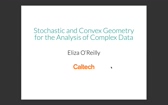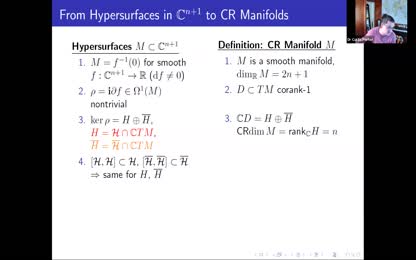Oguz Savk : Bridging the gaps between homology planes and Mazur manifolds.
- Geometry and Topology,Uploaded Videos ( 266 Views )We call a non-trivial homology 3-sphere a Kirby-Ramanujam sphere if it bounds a homology plane, an algebraic complex smooth surface with the same homology groups of the complex plane. In this talk, we present several infinite families of Kirby-Ramanujam spheres bounding Mazur type 4-manifolds, compact contractible smooth 4-manifolds built with only 0-, 1-, and 2-handles. Such an interplay between complex surfaces and 4-manifolds was first observed by Ramanujam and Kirby around nineteen-eighties. This is upcoming joint work with Rodolfo Aguilar Aguilar.
Eliza O’Reilly : Stochastic and Convex Geometry for Complex Data Analysis
- Colloquium Seminar,Colloquium,Uploaded Videos ( 771 Views )Many modern problems in data science aim to efficiently and accurately extract important features and make predictions from high dimensional and large data sets. Naturally occurring structure in the data underpins the success of many contemporary approaches, but large gaps between theory and practice remain. In this talk, I will present recent progress on two different methods for nonparametric regression that can be viewed as the projection of a lifted formulation of the problem with a simple stochastic or convex geometric description, allowing the projection to encapsulate the data structure. In particular, I will first describe how the theory of stationary random tessellations in stochastic geometry can address the computational and theoretical challenges of random decision forests with non-axis-aligned splits. Second, I will present a new approach to convex regression that returns non-polyhedral convex estimators compatible with semidefinite programming. These works open many directions of future work at the intersection of stochastic and convex geometry, machine learning, and optimization.
Roman Vershynin : Mathematics of synthetic data and privacy
- Probability,Uploaded Videos ( 1056 Views )An emerging way to protect privacy is to replace true data by synthetic data. Medical records of artificial patients, for example, could retain meaningful statistical information while preserving privacy of the true patients. But what is synthetic data, and what is privacy? How do we define these concepts mathematically? Is it possible to make synthetic data that is both useful and private? I will tie these questions to a simple-looking problem in probability theory: how much information about a random vector X is lost when we take conditional expectation of X with respect to some sigma-algebra? This talk is based on a series of papers with March Boedihardjo and Thomas Strohmer.
David Aldous: Probability Seminar
- Probability,Uploaded Videos ( 611 Views )David Aldous, Probability Seminar Sept 30, 2021 TITLE: Can one prove existence of an infectiousness threshold (for a pandemic) in very general models of disease spread? ABSTRACT: Intuitively, in any kind of disease transmission model with an infectiousness parameter, there should exist a critical value of the parameter separating a very likely from a very unlikely resulting pandemic. But even formulating a general conjecture is challenging. In the most simplistic model (SI) of transmission, one can prove this for an essentially arbitrary large weighted contact network. The proof for SI depends on a simple lemma concerning hitting times for increasing set-valued Markov processes. Can one extend to SIR or SIS models over similarly general networks, where the lemma is no longer applicable?
Measure-Theoretic Dvoretzky Theorem and Applications to Data Science
- Probability,Uploaded Videos ( 1393 Views )SEPC 2021 in honor of Elizabeth Meckes. Slides from the talks and more information are available <a href="https://services.math.duke.edu/~rtd/SEPC2021/SEPC2021.html">at this link (here).</a>
Curtis Porter : CRash CouRse in CR Geometry
- Graduate/Faculty Seminar,Uploaded Videos ( 2178 Views )CR geometry studies real hypersurfaces in complex vector spaces and their generalizations, CR manifolds. In many cases of interest to complex analysis and PDE, CR manifolds can be considered ``curved versions" of homogeneous spaces according to Elie Cartan’s generalization of Klein’s Erlangen program. Which homogeneous space is the ``flat model" of a CR manifold depends on the Levi form, a tensor named after a mathematician who used it to characterize boundaries of pseudoconvex domains. As in the analytic setting, the Levi form plays a central role in the geometry of CR manifolds, which we explore in relation to their homogeneous models.
Holden Lee : Recovering sparse Fourier signals, with application to system identification
- Graduate/Faculty Seminar,Uploaded Videos ( 1018 Views )The problem of recovering a sparse Fourier signal from samples comes up in signal processing, imaging, NMR spectroscopy, and machine learning. Two major challenges involve dealing with off-grid frequencies, and dealing with signals lacking separation between frequencies. Without a minimum separation condition, the problem of frequency recovery is exponentially ill-conditioned, but the signal can still be efficiently recovered in an "improper" manner using an appropriate filter. I will explain such an algorithm for sparse Fourier recovery, and the theory behind why it works - involving some clever analytic inequalities for Fourier-sparse signals. Finally, I will discuss recent work with Xue Chen on applying these ideas to system identification. Identification of a linear dynamical system from partial observations is a fundamental problem in control theory. A natural question is how to do so with statistical rates depending on the inherent dimensionality (or order) of the system, akin to the sparsity of a signal. We solve this question by casting system identification as a "multi-scale" sparse Fourier recovery problem.
Stochastic and continuum dynamics in intracellular transport
- Graduate/Faculty Seminar,Uploaded Videos ( 1072 Views )The cellular cytoskeleton is made up of protein polymers (filaments) that are essential in proper cell and neuronal function as well as in development. These filaments represent the roads along which most protein transport occurs inside cells. I will discuss several examples where questions about filament-cargo interactions require the development of novel mathematical modeling, analysis, and simulation. Protein cargoes such as neurofilaments and RNA molecules bind to and unbind from cellular roads called microtubules, switching between bidirectional transport, diffusion, and stationary states. Since these transport models can be analytically intractable, we have proposed asymptotic methods in the framework of partial differential equations and stochastic processes which are useful in understanding large-time transport properties. I will discuss a recent project where we use stochastic modeling to understand how filament orientations may influence sorting of cargo in dendrites during neural development and axonal injury.
Zoe Huang : Motion by mean curvature in interacting particle systems
- Probability,Uploaded Videos ( 1195 Views )There are a number of situations in which rescaled interacting particle systems have been shown to converge to a reaction diffusion equation (RDE) with a bistable reaction term. These RDEs have traveling wave solutions. When the speed of the wave is nonzero, block constructions have been used to prove the existence or nonexistence of nontrivial stationary distributions. Here, we follow the approach in a paper by Etheridge, Freeman, and Pennington to show that in a wide variety of examples when the RDE limit has a bistable reaction term and traveling waves have speed 0, one can run time faster and further rescale space to obtain convergence to motion by mean curvature. This opens up the possibility of proving that the sexual reproduction model with fast stirring has a discontinuous phase transition, and that in Region 2 of the phase diagram for the nonlinear voter model studied by Molofsky et al there were two nontrivial stationary distributions.
Yiming Zhong : Fast algorithm for Radiative transport
- Graduate/Faculty Seminar,Uploaded Videos ( 946 Views )This talk consists of two aspects about solving the radiative transport through the integral formulation. The radiative transport equation has been numerically studied for many years, the equation is difficult to solve due to its high dimensionality and its hyperbolic nature, in recent decades, the computers are equipped with larger memories so it is possible to deal with the full-discretization in phase space, however, the numerical efficiency is quite limited because of many issues, such as iterative scheme, preconditioning, discretization, etc. In this talk, we first discuss about the special case of isotropic scattering and its integral formulation, then walk through the corresponding fast algorithm for it. In the second part, we try to trivially extend the method to anisotropic case, and talk about the method’s limitation and some perspectives in both theory and numerics.
Alex Hening : Stochastic persistence and extinction
- Probability,Uploaded Videos ( 1171 Views )A key question in population biology is understanding the conditions under which the species of an ecosystem persist or go extinct. Theoretical and empirical studies have shown that persistence can be facilitated or negated by both biotic interactions and environmental fluctuations. We study the dynamics of n interacting species that live in a stochastic environment. Our models are described by n dimensional piecewise deterministic Markov processes. These are processes (X(t), r(t)) where the vector X denotes the density of the n species and r(t) is a finite state space process which keeps track of the environment. In any fixed environment the process follows the flow given by a system of ordinary differential equations. The randomness comes from the changes or switches in the environment, which happen at random times. We give sharp conditions under which the populations persist as well as conditions under which some populations go extinct exponentially fast. As an example we look at the competitive exclusion principle from ecology, which says in its simplest form that two species competing for one resource cannot coexist, and show how the random switching can facilitate coexistence.
Demetre Kazaras:The geometry and topology of positive scalar curvature
- Graduate/Faculty Seminar,Uploaded Videos ( 1600 Views )I will give an informal overview of the history and status of my field. Local invariants of Riemannian metrics are called curvature, the weakest of which is known as "scalar curvature." The study of metrics with positive scalar curvature is very rich with >100 year old connections to General Relativity and smooth topology. Does this geometric condition have topological implications? The answer turns out to be "yes," but mathematicians continue to search for the true heart of the positive scalar curvature conditions.
Margaret Regan : Using homotopy continuation to solve parametrized polynomial systems in applications
- Graduate/Faculty Seminar,Uploaded Videos ( 1696 Views )Many problems that arise in mathematics, science, and engineering can be formulated as solving a parameterized system of polynomial equations which must be solved for given instances of the parameters. One way to solve these systems is to use a common technique within numerical algebraic geometry called homotopy continuation. My talk will start with background on homotopy continuation and parametrized polynomial systems, followed by applications to problems in computer vision and kinematics. Of these, I will first present a new approach which uses locally adaptive methods and sparse matrix calculations to solve parameterized overdetermined systems in projective space. Examples will be provided in 2D image reconstruction to compare the new methods with traditional approaches in numerical algebraic geometry. Second, I will discuss a new definition of monodromy action over the real numbers which encodes tiered characteristics regarding real solutions. Examples will be given to show the benefits of this definition over a naive extension of the monodromy group (over the complex numbers). In addition, an application in kinematics will be discussed to highlight the computational method and impact on calibration.
Oliver Tough : The Fleming-Viot Particle System with McKean-Vlasov dynamics
- Probability,Uploaded Videos ( 1258 Views )Quasi-Stationary Distributions (QSDs) describe the long-time behaviour of killed Markov processes. The Fleming-Viot particle system provides a particle representation for the QSD of a Markov process killed upon contact with the boundary of its domain. Whereas previous work has dealt with killed Markov processes, we consider killed McKean-Vlasov processes. We show that the Fleming-Viot particle system with McKean-Vlasov dynamics provides a particle representation for the corresponding QSDs. Joint work with James Nolen.

 yes
yes



















